Barry (2000: 22) analyzed ceramics weighing 262.8 kilograms from the site. The proportions according to general types were 63 percent Chinese porcelain; 18 percent Asian stoneware; 7 percent European white earthenware; 7 percent European stoneware; 3 percent Asian earthenware; and 2 percent of miscellaneous origin.
Koh (1989) listed six categories of artifacts: Chinese porcelain, Chinese stoneware, European ware, glass and pottery (earthenware), slate (rock), and coins. Coins were relatively rare; they included British coins dated 1872, 1873, and 1883, and a Sarawak coin dated 1883 (Koh 1989: 68–9). European sherds comprised fewer than five percent of the ceramics collected. These included such items as six intact European stoneware bottles (Koh 1989: 71, Fig. 44), and clay tobacco pipes (Koh 1989: 72). One cluster of stoneware gin bottles was found a meter away from another cluster of glass liquor bottle sherds, with heavily devitrified light green necks and spiral glass strands (Fig. 48). They are “dated no later than 1870” (Koh 1989: 72). Other European artifacts included slates, probably used for roofing as is common in England (Koh 1989: Fig. 56). Similar objects were found in an excavation at St. Andrew’s Cathedral, where the roof was originally made of this material.
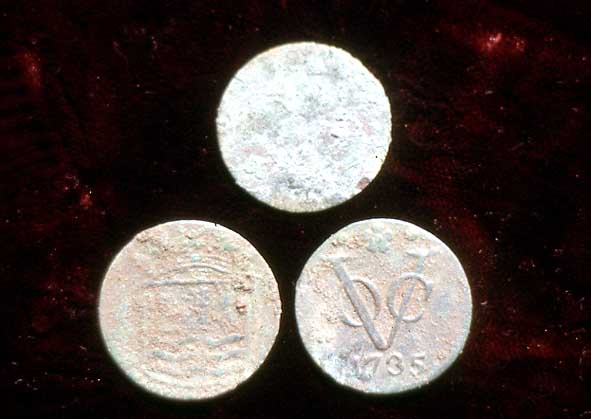
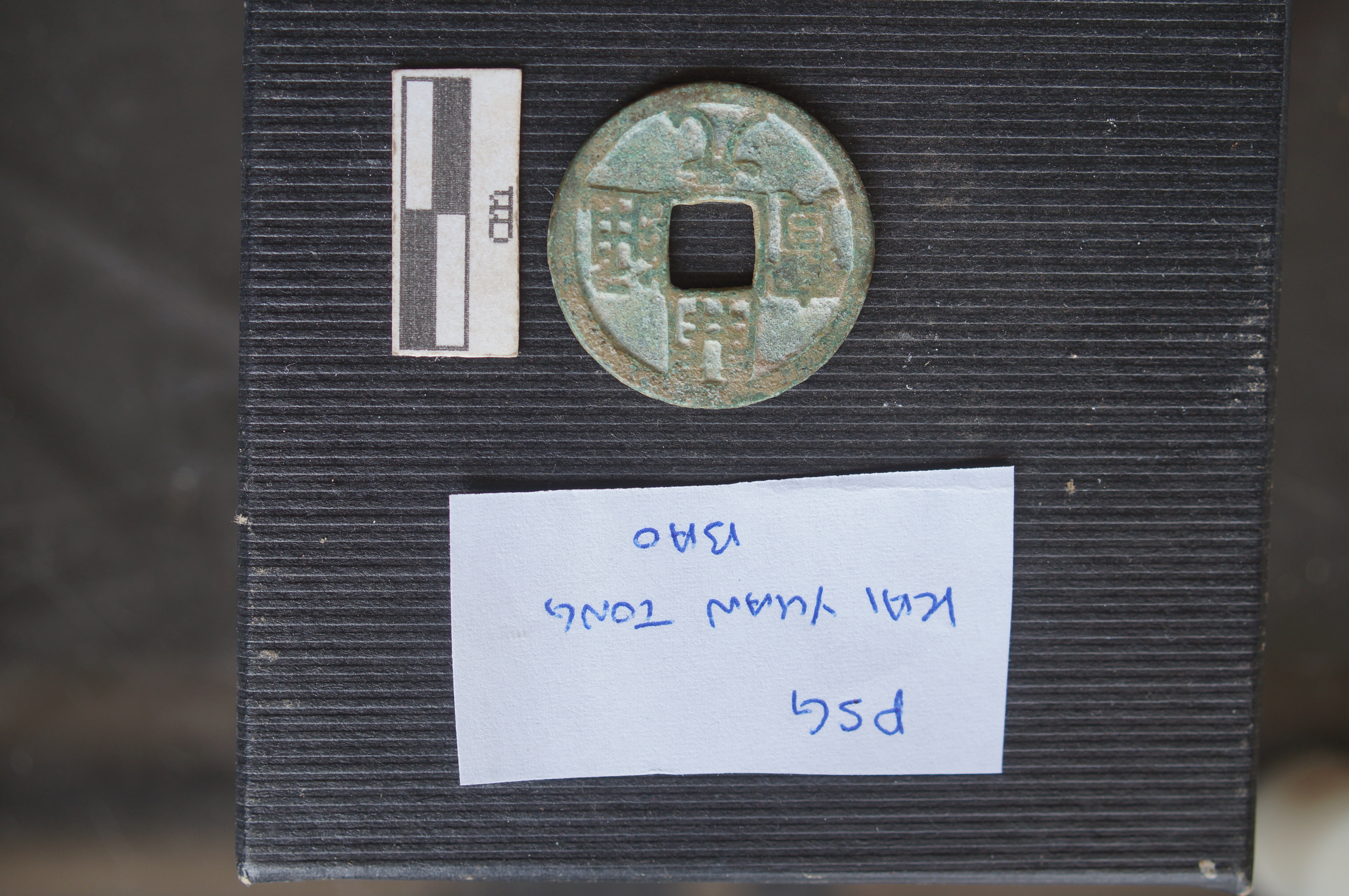
A few sherds of earthenware were found, some of which may be premodern. Their rarity in the assemblage may be partly due to sampling bias since they are more difficult to see when they are covered with mud and are also more fragile. Koh divided them into four groups (Koh 1989: 73). Some jarlet sherds were decorated with geometric patterns (Koh 1989: Fig. 52), impressed squares (Koh 1989: Fig. 53), or “corded patterns” with traces of pyrite that were probably made by using carved paddles or jabbing with a pointed tool (Koh 1989: Figs. 54–5). Barry (2000: 35) recorded that earthenware comprised 7.1 kilograms or 3 percent of all sherds by weight. She discerned three types: coarse, fine paste, and semi-fine white bodied types. Coarse brown or gray-bodied sherds numbered 208; 16 are decorated with incised, stamped, pecked, paddle-impressed, and mat-impressed designs; four have traces of red paint. There were 12 pink fine paste sherds; 16 pinkish-white soft fine paste sherds. Seven sherds were classified as intermediate examples, six of which are paddle-impressed.
Some natural objects such as shells were also collected. Many exhibit holes drilled in them. Barry (1996: 4) includes the information that “[Emily] Glover notes that holes evident in many examples were drilled by predatory molluscs rather than by man as proposed by Koh in his case for a prehistoric habitation of the site.” Other items once thought to be possible prehistoric items are now known to be bone toothbrushes.
Chinese porcelain was the most varied category by far. Koh (1989) identified 31 groups of Chinese porcelain: bowls with double-happiness characters; Straits or Peranakan blue and white bowls with formalized scrolls and butterfly motifs; “batik bowls” (a term coined by William Willets 1981: 11). Chinese porcelain with red seal marks of the Tongzhi reign are other items datable to the 19th century that were found.
Barry (2000: 24) devised a classification system consisting of monochromes, underglaze blue, and “provincial blue and white ware”. Monochrome whitewares or overglaze polychromes cannot be assigned to production sites (Barry 2000: 24). The identifiable monochromes were subdivided into “Qing green”, dark blue, and coral-red. These are usually attributed to Jingdezhen, though Ho (1988: 12) showed that Fujian also produced blue and green monochromes. The underglaze was also made both at Jingdezhen and other kilns, some of which were popular among Chinese both in China and overseas, and some were made for European markets such as the willow and Fitzhugh patterns (Barry 2000: Fig. 8). An almost intact planter (Fig. 9) was probably made for the Japanese market.
Provincial blue and white ware comprised 54 percent of the Asian porcelain analyzed by Barry, or 45 percent of the entire ceramic assemblage. Ho (1988: 3) called it Min Yao; Willetts called it Kitchen Qing (Willetts 1981). Comparable examples have been found at other sites, of which examples from Tioman have been published(Lam et al 1985: 134; Yeo and Martin 1978: 286). Some patterns were made at a single manufacturing center in Fujian, but others were widespread.
These provincial wares vary greatly in quality. Barry (2000: 26) distinguished three grades of quality (I, II, and III, plus intermediate types I/II, II/III). Some motifs such as Sweet Pea Blossom and Foliage; Chrysanthemum and Flower Stalks; and Book, Bamboo, Prunus, and Peony can be found in all three grades. Double Happiness and Scrolls, or Fungus of Immortality, Fruiting Peach and Spiral are only found in Grades II and III. Hand-painted Butterflies and Formalized Scrolls (Barry 2000: Figs. 19–21) appear only in Grade I; block-printed versions are found in both fine (Fig. 27) and coarse vessels (Fig. 29).
Grade III wares are closer to stoneware. Stacking rings and sand adhesions are common features on Grade III wares (Fig. 26). Block printing was almost always associated with Grade III wares. Exceptions include one Grade II Butterflies and Formalized Scrolls bowl (Fig. 27), European coat of arms, Chrysanthemum and Devolved Conch Shell (Barry 2000: 27, Fig. 27) and Sanskrit character for om (Fig. 28).
Block printing was sometimes combined with hand-painted décor. Block-printed wares comprised 18 percent of the underglaze blue provincial wares. Grade II block-printed examples weighed 4.34 kilograms, while those of Grade III weighed 10.33 kilograms. A few sherds of Batavia Ware (chocolate brown exteriors, underglaze blue on a white background) were found: a Sweet Pea Blossom and Foliage wash basin, and a saucer with Fish among Waterweeds (Fig. 31).
A few sherds of underglaze blue were combined with copper red fish (Fig. 32). In another variation, underglaze blue paintings are found under a watery green glaze (Fig. 33). According to Ho Wing Meng (1953: 126) these were made for Baba households.
Barry (2000: 29, Fig. 37) identified a few unusual sherds as belonging to the types called Nonya Ware (found mainly in sites in the Malaysia-Indonesia region) and Bencharong sherds (found mainly in Thailand) made at Jingdezhen (Lim Suan Poh 1981: 17, 19; Harrisson 1988: 70). Bencharong is usually dated a century earlier than Nonya ware, between 1750–1850 (Harrisson 1988: 70–2). These two types together only weighed 0.58 kilograms. It is possible that these sherds belong to other, as yet unrecognized, types.
Barry (2000: 30, Figs. 38–40) also identified a few stencil-printed blue and white sherds sometimes combined with stamped or hand-painted designs like Hizen ware made in Japan. These weighed 1.89 kilograms. Other types such as underglaze blue printed wares (Fig. 41; 31, Fig. 42) are of uncertain origin. Other unidentified sherds include one reminiscent of Egg and Spinach (Fig. 43), green-glazed molded sherds (Fig. 44), and brown or black shiny glazed jarlets and bean pots.
Chinese stoneware exhibited a wide range of shapes, including a spittoon-shaped vase, almost intact (Koh 1989: 68, Fig. 36). Koh divided Chinese stoneware into eight groups, including several types of jars potentially used for containing wine, probably made in Fujian, and famous Yixing ware used for teapots. One has an eight-character poem engraved on the base; another has the names of three persons impressed on the body (Koh 1989: Figs. 39–40).
Barry (2000: 32) did not conduct detailed analysis of stoneware, but she did identify five groups. The first group consists of fine, brown-glazed ware, including opium pots, spoons, vases, covered boxes, jars, jarlets (Fig. 46). The second group is “brittle ware” (Fig 47., top), whose texture more closely resembles buff rather than brittle stoneware with fine handles and thin bodies. Examples were found in the cargo of the Diana, which sank in 1817 (Christie’s 1995: 60). These also include pots, probably used for boiling herbs to make medicine, and cake stamps (Barry 2000: 33). The third group consists mainly of thick-bodied clunky objects with streaky colors, and some raised clay dots. These were possibly once darker but are now mostly white with a little green and are similar to some architectural objects like balusters. The fourth group includes coarse, brown-glazed ware, mainly fragments of large jars decorated with paddle marks and the like (Barry 2000: 34). She does not provide photographs of these. The fifth group comprises Yixing or Yixing-type ware and an unusual plum colored urinal, possibly from Shiwan (Barry 2000: Fig. 45).
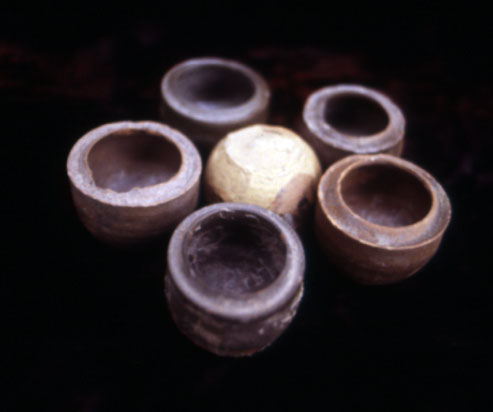

Barry (2000: 36) next dealt with European white earthenware of the type invented in Staffordshire. These are usually decorated with transfer-printed patterns or painted by hand or sponge in the Gaudy Dutch manner. These were made in several parts of Europe in the 19th and 20th centuries. At Pulau Saigon, white earthenware comprises 52 percent of all European ware, which was 7 percent of the entire ceramic assemblage that she analyzed.
The transfer-printed subtype appears in numerous designs. Blue designs modeled on Chinese patterns were most popular, as was Wild Rose (Fig. 49), made from the 1820s to 1860s in various places including Petrus Regout in Maastricht and Robert Cochran in Glasgow. The famous Blue Willow appeared in Staffordshire in the early 1800s and was sold to Petrus Regout in 1855. It was also made in at least ten factories in Scotland (Cruickshank 1987: 12). Blue is the most common color at Pulau Saigon (PSG) (Barry 2000: 37, Figs. 49–50), followed by red (Figs. 51–52), brown (Fig. 53), green (Fig. 53), mauve (Fig. 54), and black. A decorative technique called “flow blue” is found on PSG examples made during the 1860s and 1870s. A similar type is also found, dated between 1860–1880 (Barry 2000: Fig. 55).
A special type of transfer-printed ware was made for Southeast Asian markets, mainly in Scotland, but also in Belgium, England, France, Germany, and Netherlands. Many patterns had Asian names such as Johore, Kim Ki Soah, or Kwantung (Fig. 56). Robert Cochran made a pattern called Butterfly and Rose, which other British potteries called Singapore or Penang. J. & M.P. Bell in Glasgow registered 30 patterns for Southeast Asia with the Patent Office between 1887 to 1906 (Cruikshank 1987: 24). Many were printed in two colors (e.g. the Johore pattern, Fig. 56).
Barry (2000: 38) cites a personal communication from Graeme Cruikshank in which he identified some patterns as possibly designed for Straits-born (Peranakan) Chinese, decorated with floral sprays on the rim and cavetto, while the central area is mainly plain (Barry 2000: Fig. 57). These were made by the Johnson Brothers of Staffordshire in the 1920s; similar types were also made in Maastricht. After 1945, Japanese potteries imitated this pattern as well.
In Barry’s sample, transfer-printed ware constituted 7.27 kilograms, of which 4.84 kilograms are blue, 0.4 kilograms are identified provisionally as Peranakan, and only 0.22 kilograms are Scottish export ware with Asian designs.
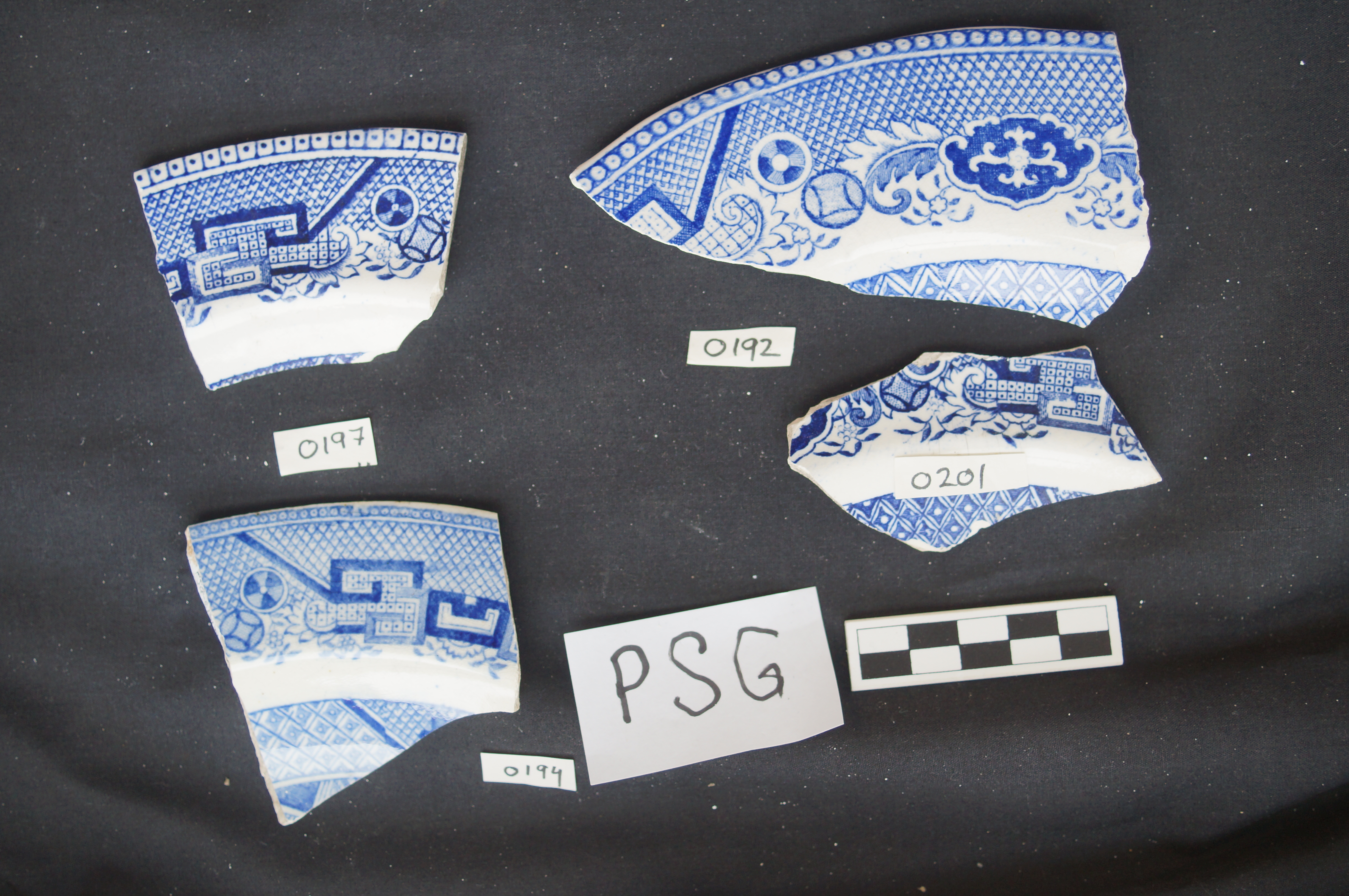
Colorful hand-painted and sponge-printed ceramics termed Gaudy Dutch were also made in Wales, England, Scotland, and Japan. Production of Gaudy Dutch began in Scotland from 1855. Similar examples were found in Canada (Cruikshank 1982: 7). Some were found at the Spode site in Stoke-on-Trent. Barry (2000: 39, Figs. 58–9) illustrates hand-painted and sponge-printed examples. These comprised 4.17 kilograms in her sample.
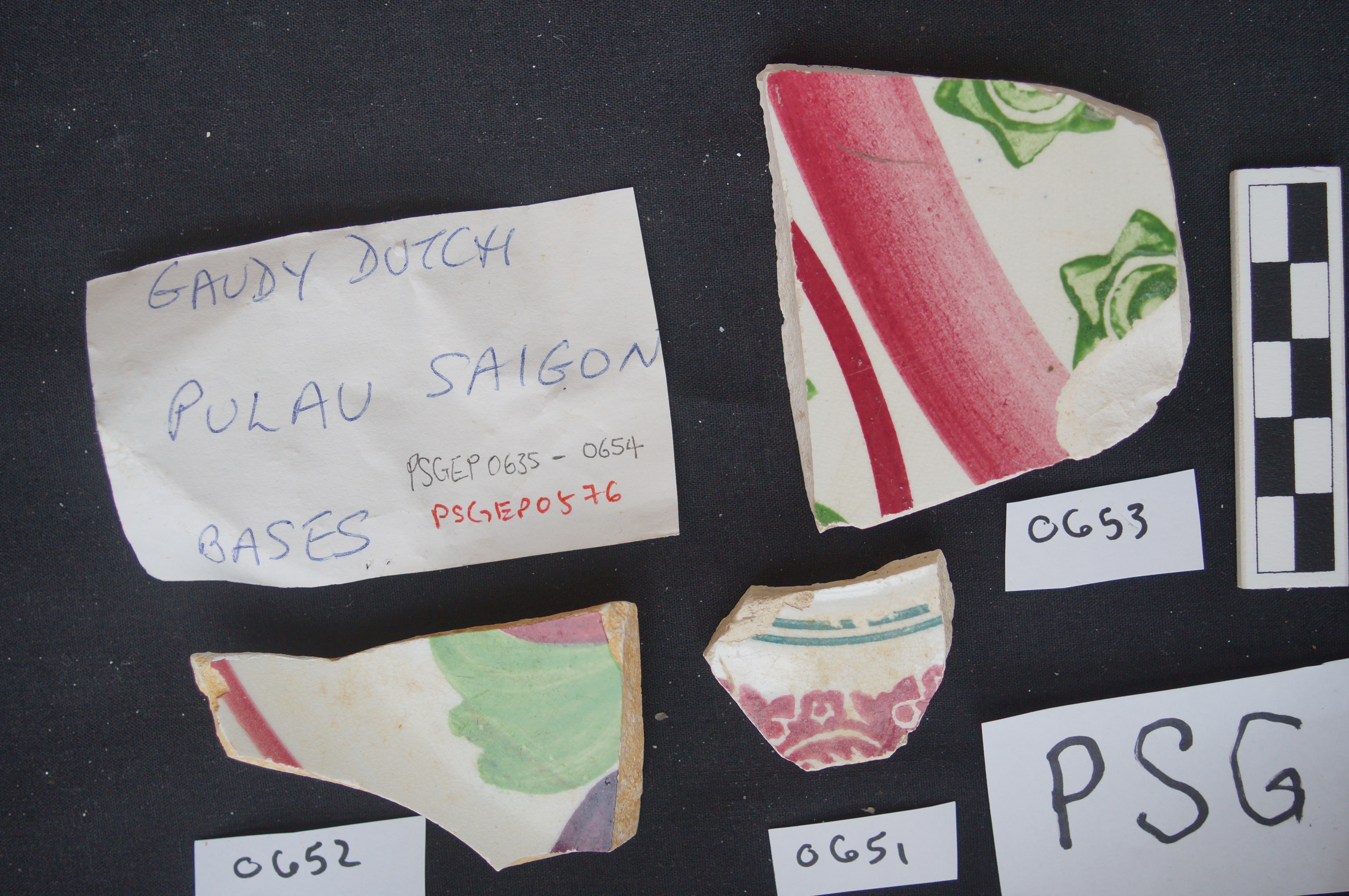
European stoneware was more common in her sample, at least by weight (17.6 kilograms; Barry 2000: 40). All except for one olive green sherd could be assigned to one of three known types. British and German stoneware were almost exactly equal in number (37 and 39 sherds). One well-known type, Rhineland salt-glazed ware, has been exported since the mid-15th century. All examples are mineral water bottles made in Nassau County (Barry 2000: Fig. 60). Some intact British bottles were recovered. These were probably tossed into the river after their contents were imbibed. These consisted of English and Scottish brown salt-glazed wares. A particularly European object recovered was a salt-glazed blacking bottle (Barry 2000: 41, Fig. 62).
Clear-glazed stoneware developed in Bristol in 1835 eventually replaced salt glazing. Bottles of this ware were used to store ginger beer, preserves, rennet, ink, and polish (Cruikshank 1987: 13). Some were partially dipped in brown glaze, creating a contrast with the creamy white body (Barry 2000: Fig. 62). Scottish stoneware is generally paler than English.
The assemblage analyzed by Barry included relatively few artifacts from the period after World War II, possible due in part to the collection procedure. (Barry 2000: 42). Of the artifacts she analyzed, she distinguished five main groups, some of which are Chinese, while others cannot be assigned to a specific provenance.